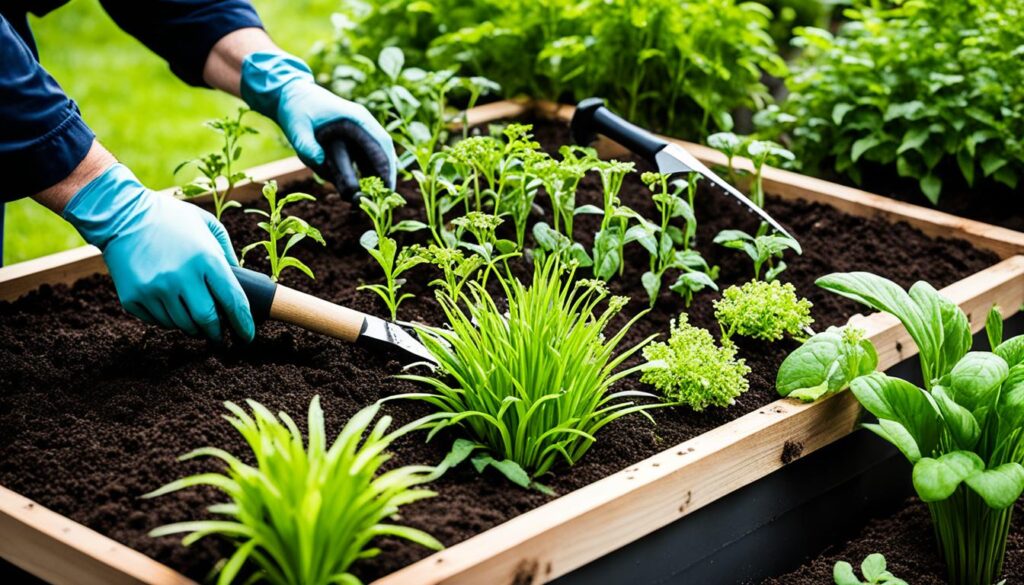
Combat Moldy Soil: Effective Remediation Steps
In this section, we will discuss the steps you can take to effectively fix moldy soil in your garden. Having moldy soil can be a frustrating problem for any gardener, but by following the right techniques, you can easily tackle this issue and create a healthy environment for your plants.
Moldy soil is typically caused by excessive moisture, poor drainage, or improper organic matter decomposition. It can lead to stunted plant growth, root diseases, and overall poor garden performance. By addressing the root cause and implementing the following moldy soil treatment steps, you can bring your soil back to optimum condition:
1. Identify the source of excessive moisture and correct it. This may involve improving drainage, redirecting water flow, or adjusting irrigation practices.
2. Remove any visible mold growth or infected plant materials from the soil. Use a trowel or garden fork to carefully lift and remove affected areas.
3. Incorporate organic matter into the soil to promote a healthy microbial balance. This can help prevent future mold growth and improve overall soil structure.
4. Ensure proper aeration of the soil by loosening compacted areas. Use a garden fork or aeration tool to break up soil clumps and improve air circulation.
5. Monitor soil moisture levels regularly and adjust watering as needed. Aim for a balanced level of moisture that is suitable for the specific needs of your plants.
6. Consider using natural mold prevention methods, such as applying beneficial microbes or using organic fungicides, to suppress mold growth in the soil.
Key Takeaways:
- Excessive moisture and poor drainage are common causes of moldy soil.
- Identifying and correcting the source of excessive moisture is crucial for effective moldy soil treatment.
- Removing visible mold growth and incorporating organic matter can help prevent future mold growth.
- Aerating the soil and monitoring moisture levels are essential for maintaining a healthy soil environment.
- Natural mold prevention methods, including beneficial microbes and organic fungicides, can be useful in suppressing mold growth.
Organic Soil Care: Key to Mold Prevention and Soil Health
When it comes to maintaining a healthy garden, organic soil care is key. Not only does it promote the overall well-being of your plants, but it also plays a crucial role in preventing mold growth and ensuring optimal soil health. In this section, we will delve into the importance of organic soil care and provide valuable tips and solutions to combat moldy soil using natural methods.
Soil Pollution Remedies
To effectively protect your soil from pollution, it’s important to employ organic remedies that are environmentally friendly. Avoid the use of synthetic fertilizers, pesticides, and herbicides that can harm the delicate balance of soil ecosystems. Instead, opt for organic alternatives such as compost, mulch, and natural pest control methods to maintain a healthy soil environment.
Soil Health Tips
Maintaining optimal soil health is crucial for preventing mold growth and promoting a thriving garden. Here are some practical tips:
- Test your soil regularly to assess nutrient levels and pH balance. This will help you determine any necessary amendments or adjustments.
- Aerate the soil to improve drainage and prevent waterlogging, which can lead to mold growth.
- Ensure proper watering techniques, aiming for deep and infrequent watering rather than frequent shallow watering.
- Rotate your crops to prevent the buildup of pathogens and discourage mold growth.
- Provide adequate organic matter, such as compost, to enrich and nourish the soil.
Moldy Soil Solutions
If you encounter moldy soil in your garden, there are organic solutions that can effectively address the issue:
- Remove the affected soil and replace it with fresh, healthy soil.
- Apply organic fungicides or homemade solutions such as neem oil or chamomile tea to control mold growth.
- Ensure proper drainage and prevent overwatering to discourage mold formation.
- Introduce beneficial microbes and fungi through the use of compost tea or mycorrhizal inoculants, which can help suppress mold growth.
By implementing these organic soil care practices and effectively addressing moldy soil issues, you can maintain a healthy and vibrant garden. Let’s move on to the next section to summarize the key points and conclude our discussion on moldy soil prevention and soil health.

Conclusion
After exploring the steps to fix moldy soil, the importance of organic soil care, and the impact of soil health on your garden, it is clear that proactive measures and organic practices are key to maintaining a thriving garden. By implementing the right mold prevention techniques and following the remediation steps, you can effectively address the issue of moldy soil.
Soil pollution remedies, such as proper drainage and regular soil testing, are essential to prevent the growth of mold in your garden. Additionally, incorporating organic soil care practices, like using compost and avoiding chemical fertilizers, promotes a healthy soil ecosystem that is resistant to mold and other soil-related issues.
Remember to prioritize regular garden soil maintenance, such as proper watering and weed control, as healthy soil is the foundation for a productive and vibrant garden. By following these tips and adopting organic soil care methods, you can enjoy a mold-free garden and reap the rewards of a flourishing outdoor space.




